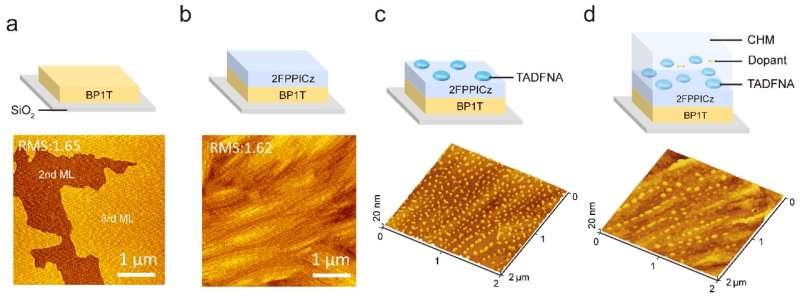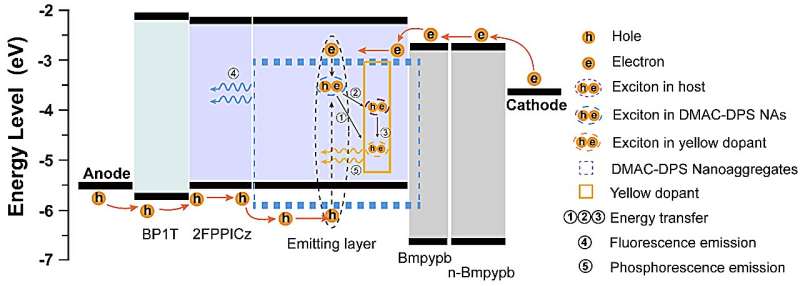This article has been reviewed according to Science X's editorial process and policies. Editors have highlighted the following attributes while ensuring the content's credibility:
fact-checked
peer-reviewed publication
trusted source
proofread
Researchers report structure for developing high-efficiency crystalline white organic light-emitting diodes

Organic light-emitting diodes (OLED) have emerged as a new generation of display technology. Organic crystalline materials possess superior thermal stability, chemical stability, and high carrier mobility, making them an ideal choice for developing luminescent devices.
Scientists in China invented a crystalline white OLED, which possesses a fast ramping of luminance and achieves a low series-resistance Joule-heat loss ratio and enhanced photon output, demonstrating its significant potential in developing the next-generation OLEDs.
In the context of the continuous development of information technology, people's demand for display technology and lighting equipment is growing day by day. Organic light-emitting diodes (OLEDs) have risen to prominence, thanks to their self-emitting nature, high contrast, wide color range, broad viewing angles, glare-free properties, rapid response, and flexibility.
In the commercial production of OLEDs, amorphous organic semiconductor materials are widely used due to their excellent film-forming abilities and suitability for large-area processing. Compared to amorphous materials, organic crystalline materials possess superior thermal stability, chemical stability, and high carrier mobility, making them another promising choice for developing high-performance luminescent devices.
In a new paper published in Light: Science & Applications, a team of scientists, led by Professor Donghang Yan from Changchun Institute of Applied Chemistry, Chinese Academy of Sciences, has reported crystalline host matrix (CHM) with embedded nanoaggregates (NA) structure for developing high-performance crystalline white OLEDs by employing a thermally activated delayed fluorescence (TADF) material and orange phosphorescent dopants (Phos.-D).
By applying the CHM-NA-D structure, it is possible to control luminescence behavior in a novel manner and different devices can be created by modulating the components within the structure.
This paper extends the material system of crystalline OLEDs to thermally activated delayed fluorescence (TADF). Through judicious material energy level selection and device structure design, the controlled embedding of nanoaggregates and the research on the position of phosphorescent guests within the CHM-TADFNA-D device effectively optimize the exciton formation region. This adjustment of the exciton utilization process in the device maximizes the exciton utilization rate, which is crucial for enhancing device performance.
Additionally, the contact between the crystalline host and nanoaggregates results in an organic heterojunction effect that can effectively reduce the device's conductivity, creating high-conductivity channels and ultimately reducing the driving voltage of the device.
Benefiting from the crystalline host ensuring efficient charge carrier transport channels in the device; the organic heterojunction effect between the crystalline host and nanoaggregates effectively reducing the device's conductivity; the efficient utilization of excitons by TADF nanoaggregates and phosphorescent guests; and the excellent device structure design and energy level construction, the WOLED achieved a maximum brightness of 29173 cd m-2 and an external quantum efficiency (EQE) of 12.8%, setting a new record in efficiency for WOLEDs based on crystalline materials.
Compared to traditional amorphous WOLEDs, the crystalline WOLED in this paper exhibits higher brightness, lower joule heat loss, and higher photon output efficiency at low driving voltages, demonstrating the great potential of this approach in the fabrication of white OLEDs.

The crystalline WOLED prepared by WEG method has successfully achieved high-efficiency luminescence, demonstrating the great potential of crystalline thin-film organic light-emitting diodes. The combination of a high-mobility crystalline framework and guest with high exciton utilization can broaden the design styles of device structures while ensuring the advantages of the crystalline structure, demonstrating the great potential of organic crystalline materials for developing the next-generation WOLEDs.
Currently, the energy level limitations of the host restrict the use of more high-efficiency materials. Subsequently, further development of crystalline hosts will be pursued to better expand the material system and enhance the versatility of crystalline systems.
More information: Yijun Liu et al, High-efficiency crystalline white organic light-emitting diodes, Light: Science & Applications (2024). DOI: 10.1038/s41377-024-01428-y
Journal information: Light: Science & Applications
Provided by Chinese Academy of Sciences





















